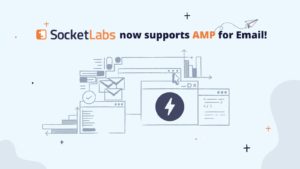
What is AMP for Email?
When discussing AMP for email, we first need to define what it is. AMP stands for Accelerated Mobile Pages, and is an open source HTML framework backed by JavaScript. It was developed by Google to allow users to create light-weight, quick, interactive, mobile HTML pages. Since AMP was created, marketers have been using it to improve their landing pages, blogs, websites, and even their email.
AMP for email allows marketers and developers to apply the same lightweight, interactive feel to their emails as they can on web pages, blog posts, etc.
Is AMP for Email Important?
Email isn’t a new technology and to be honest, not much has changed in email over the last 10+ years. Sure, there have been security improvements and other tweaks here and there, but there really have not been any significant changes to email as a communication technology. And while email is growing in popularity and becoming an increasingly powerful communication tool for businesses and consumers, it could still use a little refresher.
That’s exactly where AMP for email comes in. AMP allows developers and marketers to use email like it hasn’t been used before. And while standard email marketing can be extremely effective when done right, AMP email will add a new level of interactivity and design.
So yes, AMP for email is very important. It revitalizes a relatively untouched communication platform that will bring many benefits to email marketers all over the world. Let’s dive a little deeper into how AMP email can benefit you and then go into some actual amp email examples.
Top 3 Benefits of AMP Email
Here are some of the biggest benefits for email senders looking to incorporate AMP into their email strategy:
1. Email Capabilities
With an AMP email, senders can take action directly in emails rather than being routed to a linked website. For example an RSVP or a poll can be included directly in the email copy and can be fully interactive. We will give some specific examples of these features below.
2. Security
AMP for email is a very secure framework that does not work with any third party features or add-ons or allow any advertisements that could weaken the security of the framework. Also, every AMP email needs to be approved by Google for security reasons which is good if security is your top concern.
3. Improved Services
Because AMP for email is highly interactive and dynamic to the recipient, retrieving customer feedback, thoughts, subscribers, ratings, etc. is made much easier with AMP. Now rather than asking customers to follow a drawn-out path to submit/voice their opinion, they can do so right in the email with minimal friction. This should help improve response rates and overall engagement.
Components of AMP for Email
Within the framework of AMP for email, users have the ability to add certain components that will elevate the experience for the recipient. AMP email components are broken down into three categories:
- Dynamic Content
- Layout
- Media
For in depth detail about all of the components that are a part of AMP and how to implement them, visit the AMP website. Let’s have a look at some AMP for email examples.
Here is our favorite component from each category:
1. AMP-Form
Within the dynamic Content category of the amp components is an element called amp-form. AMP-form allows email recipients to easily and quickly fill out fields and submit a form right within the email. This can make tasks like filling out a survey or expressing interest in a product/service very easy and frictionless for the user. To learn more about amp-form check out more info from the AMP page.
2. AMP-Carousel
Within the layout category of the AMP components is an element called amp-carousel. Carousel allows users to interact/navigate images on a horizontal axis. This allows a better user experience for emails with visuals. To learn more about amp-carousel check out more info from the AMP page.
3. AMP-Anim
Within the media category of the AMP components for email is an element called amp-anim. Amp-anim is very similar to amp-img but it allows AMP runtime to reduce CPU usage when an animated image is off-screen. To learn more about amp-animl check out more info on the AMP page.
How to Send AMP Email with SocketLabs
Ready to get started with AMP for Email? SocketLabs currently supports AMP for Email in the following ways, with additional features likely to be added in the upcoming months:
First thing is first, if you want to send AMP email, you will need to pre-register here with Google. To get registered, you will need to authenticate emails using SPF, DKIM, and DMARC as specified in the security requirements. Once you are registered, you will be able to create and send AMP email!
If you are using SMTP to transmit your message to SocketLabs, you can start using AMP for Email right away. Simply include your AMP content as the text/x-amp-html MIME part alongside the text/html and/or text/plain MIME parts.
Alternatively if you are using the Injection API to send email, simply add your AMP email content to your API call using the AmpBody property on the Message object(s) in your Messages array. All Injection API features such as merge fields are supported in the AmpBody property.
Engagement Tracking is also supported within the AMP body of your messages sent through SocketLabs. Currently, opens and clicks that happen within AMP content are treated the same as other engagement tracking events, and reported in the SocketLabs Performance Dashboard and via our Notification API as such. In the future as AMP adoption grows, we may begin to differentiate AMP engagement events vs “regular” engagement in HTML messages.







